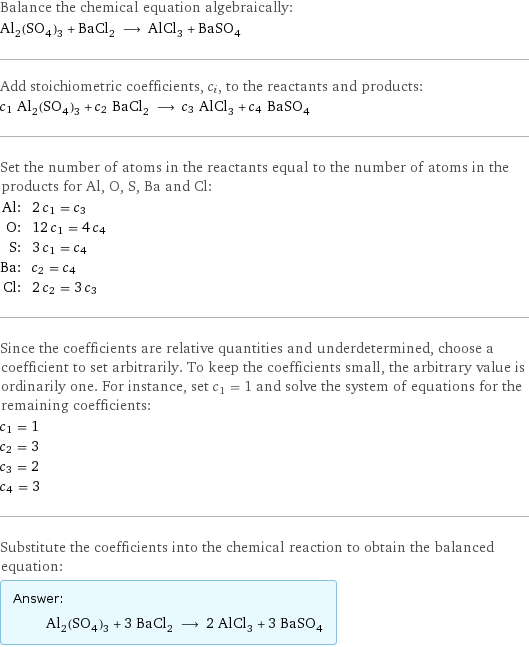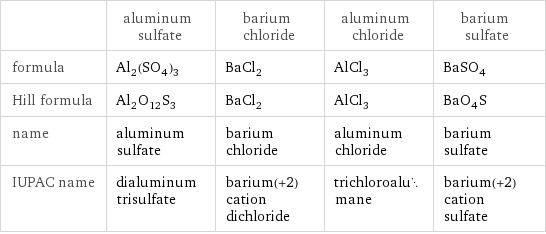Input interpretation

Al_2(SO_4)_3 aluminum sulfate + BaCl_2 barium chloride ⟶ AlCl_3 aluminum chloride + BaSO_4 barium sulfate
Balanced equation

Balance the chemical equation algebraically: Al_2(SO_4)_3 + BaCl_2 ⟶ AlCl_3 + BaSO_4 Add stoichiometric coefficients, c_i, to the reactants and products: c_1 Al_2(SO_4)_3 + c_2 BaCl_2 ⟶ c_3 AlCl_3 + c_4 BaSO_4 Set the number of atoms in the reactants equal to the number of atoms in the products for Al, O, S, Ba and Cl: Al: | 2 c_1 = c_3 O: | 12 c_1 = 4 c_4 S: | 3 c_1 = c_4 Ba: | c_2 = c_4 Cl: | 2 c_2 = 3 c_3 Since the coefficients are relative quantities and underdetermined, choose a coefficient to set arbitrarily. To keep the coefficients small, the arbitrary value is ordinarily one. For instance, set c_1 = 1 and solve the system of equations for the remaining coefficients: c_1 = 1 c_2 = 3 c_3 = 2 c_4 = 3 Substitute the coefficients into the chemical reaction to obtain the balanced equation: Answer: | | Al_2(SO_4)_3 + 3 BaCl_2 ⟶ 2 AlCl_3 + 3 BaSO_4
Structures

+ ⟶ +
Names

aluminum sulfate + barium chloride ⟶ aluminum chloride + barium sulfate
Equilibrium constant
![Construct the equilibrium constant, K, expression for: Al_2(SO_4)_3 + BaCl_2 ⟶ AlCl_3 + BaSO_4 Plan: • Balance the chemical equation. • Determine the stoichiometric numbers. • Assemble the activity expression for each chemical species. • Use the activity expressions to build the equilibrium constant expression. Write the balanced chemical equation: Al_2(SO_4)_3 + 3 BaCl_2 ⟶ 2 AlCl_3 + 3 BaSO_4 Assign stoichiometric numbers, ν_i, using the stoichiometric coefficients, c_i, from the balanced chemical equation in the following manner: ν_i = -c_i for reactants and ν_i = c_i for products: chemical species | c_i | ν_i Al_2(SO_4)_3 | 1 | -1 BaCl_2 | 3 | -3 AlCl_3 | 2 | 2 BaSO_4 | 3 | 3 Assemble the activity expressions accounting for the state of matter and ν_i: chemical species | c_i | ν_i | activity expression Al_2(SO_4)_3 | 1 | -1 | ([Al2(SO4)3])^(-1) BaCl_2 | 3 | -3 | ([BaCl2])^(-3) AlCl_3 | 2 | 2 | ([AlCl3])^2 BaSO_4 | 3 | 3 | ([BaSO4])^3 The equilibrium constant symbol in the concentration basis is: K_c Mulitply the activity expressions to arrive at the K_c expression: Answer: | | K_c = ([Al2(SO4)3])^(-1) ([BaCl2])^(-3) ([AlCl3])^2 ([BaSO4])^3 = (([AlCl3])^2 ([BaSO4])^3)/([Al2(SO4)3] ([BaCl2])^3)](../image_source/8911c0ac2803febb0e18c69a8efe8665.png)
Construct the equilibrium constant, K, expression for: Al_2(SO_4)_3 + BaCl_2 ⟶ AlCl_3 + BaSO_4 Plan: • Balance the chemical equation. • Determine the stoichiometric numbers. • Assemble the activity expression for each chemical species. • Use the activity expressions to build the equilibrium constant expression. Write the balanced chemical equation: Al_2(SO_4)_3 + 3 BaCl_2 ⟶ 2 AlCl_3 + 3 BaSO_4 Assign stoichiometric numbers, ν_i, using the stoichiometric coefficients, c_i, from the balanced chemical equation in the following manner: ν_i = -c_i for reactants and ν_i = c_i for products: chemical species | c_i | ν_i Al_2(SO_4)_3 | 1 | -1 BaCl_2 | 3 | -3 AlCl_3 | 2 | 2 BaSO_4 | 3 | 3 Assemble the activity expressions accounting for the state of matter and ν_i: chemical species | c_i | ν_i | activity expression Al_2(SO_4)_3 | 1 | -1 | ([Al2(SO4)3])^(-1) BaCl_2 | 3 | -3 | ([BaCl2])^(-3) AlCl_3 | 2 | 2 | ([AlCl3])^2 BaSO_4 | 3 | 3 | ([BaSO4])^3 The equilibrium constant symbol in the concentration basis is: K_c Mulitply the activity expressions to arrive at the K_c expression: Answer: | | K_c = ([Al2(SO4)3])^(-1) ([BaCl2])^(-3) ([AlCl3])^2 ([BaSO4])^3 = (([AlCl3])^2 ([BaSO4])^3)/([Al2(SO4)3] ([BaCl2])^3)
Rate of reaction
![Construct the rate of reaction expression for: Al_2(SO_4)_3 + BaCl_2 ⟶ AlCl_3 + BaSO_4 Plan: • Balance the chemical equation. • Determine the stoichiometric numbers. • Assemble the rate term for each chemical species. • Write the rate of reaction expression. Write the balanced chemical equation: Al_2(SO_4)_3 + 3 BaCl_2 ⟶ 2 AlCl_3 + 3 BaSO_4 Assign stoichiometric numbers, ν_i, using the stoichiometric coefficients, c_i, from the balanced chemical equation in the following manner: ν_i = -c_i for reactants and ν_i = c_i for products: chemical species | c_i | ν_i Al_2(SO_4)_3 | 1 | -1 BaCl_2 | 3 | -3 AlCl_3 | 2 | 2 BaSO_4 | 3 | 3 The rate term for each chemical species, B_i, is 1/ν_i(Δ[B_i])/(Δt) where [B_i] is the amount concentration and t is time: chemical species | c_i | ν_i | rate term Al_2(SO_4)_3 | 1 | -1 | -(Δ[Al2(SO4)3])/(Δt) BaCl_2 | 3 | -3 | -1/3 (Δ[BaCl2])/(Δt) AlCl_3 | 2 | 2 | 1/2 (Δ[AlCl3])/(Δt) BaSO_4 | 3 | 3 | 1/3 (Δ[BaSO4])/(Δt) (for infinitesimal rate of change, replace Δ with d) Set the rate terms equal to each other to arrive at the rate expression: Answer: | | rate = -(Δ[Al2(SO4)3])/(Δt) = -1/3 (Δ[BaCl2])/(Δt) = 1/2 (Δ[AlCl3])/(Δt) = 1/3 (Δ[BaSO4])/(Δt) (assuming constant volume and no accumulation of intermediates or side products)](../image_source/bfa75dd8bacbf233f5176f6849e0c483.png)
Construct the rate of reaction expression for: Al_2(SO_4)_3 + BaCl_2 ⟶ AlCl_3 + BaSO_4 Plan: • Balance the chemical equation. • Determine the stoichiometric numbers. • Assemble the rate term for each chemical species. • Write the rate of reaction expression. Write the balanced chemical equation: Al_2(SO_4)_3 + 3 BaCl_2 ⟶ 2 AlCl_3 + 3 BaSO_4 Assign stoichiometric numbers, ν_i, using the stoichiometric coefficients, c_i, from the balanced chemical equation in the following manner: ν_i = -c_i for reactants and ν_i = c_i for products: chemical species | c_i | ν_i Al_2(SO_4)_3 | 1 | -1 BaCl_2 | 3 | -3 AlCl_3 | 2 | 2 BaSO_4 | 3 | 3 The rate term for each chemical species, B_i, is 1/ν_i(Δ[B_i])/(Δt) where [B_i] is the amount concentration and t is time: chemical species | c_i | ν_i | rate term Al_2(SO_4)_3 | 1 | -1 | -(Δ[Al2(SO4)3])/(Δt) BaCl_2 | 3 | -3 | -1/3 (Δ[BaCl2])/(Δt) AlCl_3 | 2 | 2 | 1/2 (Δ[AlCl3])/(Δt) BaSO_4 | 3 | 3 | 1/3 (Δ[BaSO4])/(Δt) (for infinitesimal rate of change, replace Δ with d) Set the rate terms equal to each other to arrive at the rate expression: Answer: | | rate = -(Δ[Al2(SO4)3])/(Δt) = -1/3 (Δ[BaCl2])/(Δt) = 1/2 (Δ[AlCl3])/(Δt) = 1/3 (Δ[BaSO4])/(Δt) (assuming constant volume and no accumulation of intermediates or side products)
Chemical names and formulas

| aluminum sulfate | barium chloride | aluminum chloride | barium sulfate formula | Al_2(SO_4)_3 | BaCl_2 | AlCl_3 | BaSO_4 Hill formula | Al_2O_12S_3 | BaCl_2 | AlCl_3 | BaO_4S name | aluminum sulfate | barium chloride | aluminum chloride | barium sulfate IUPAC name | dialuminum trisulfate | barium(+2) cation dichloride | trichloroalumane | barium(+2) cation sulfate
Substance properties

| aluminum sulfate | barium chloride | aluminum chloride | barium sulfate molar mass | 342.1 g/mol | 208.2 g/mol | 133.3 g/mol | 233.38 g/mol phase | solid (at STP) | solid (at STP) | solid (at STP) | solid (at STP) melting point | 770 °C | 963 °C | 190 °C | 1345 °C density | 2.71 g/cm^3 | 3.856 g/cm^3 | | 4.5 g/cm^3 solubility in water | soluble | | | insoluble odor | | odorless | |
Units
